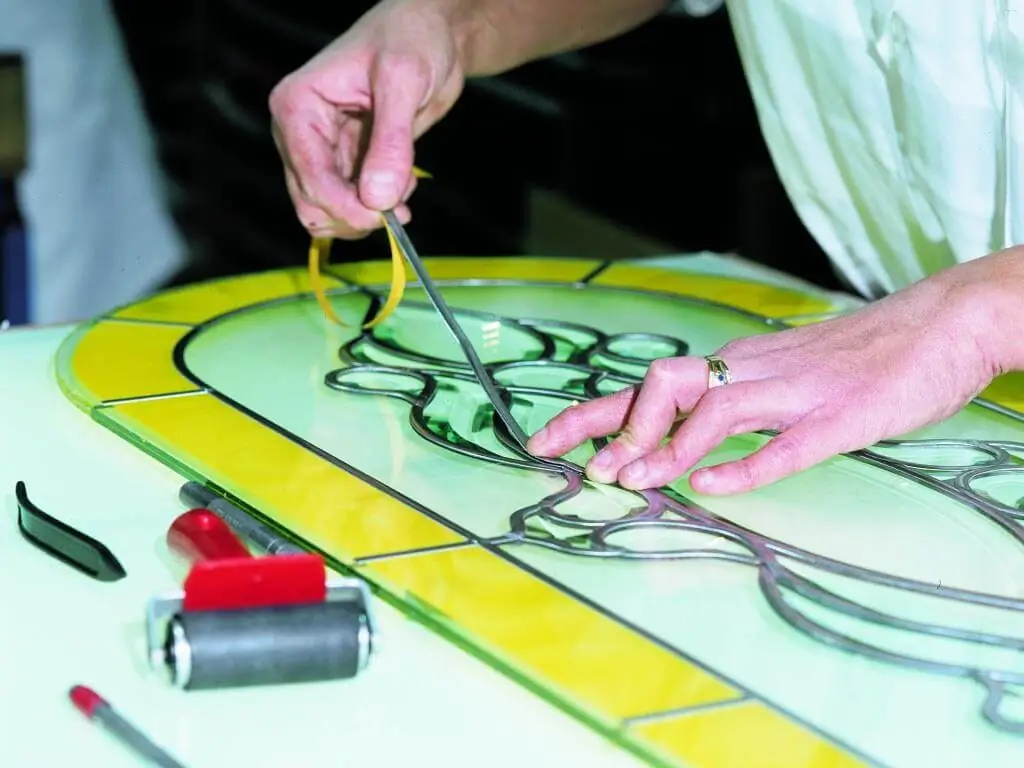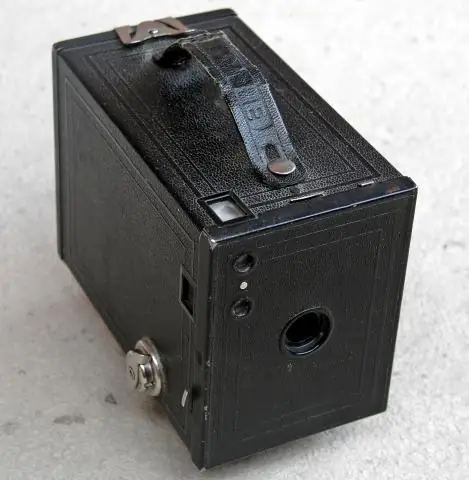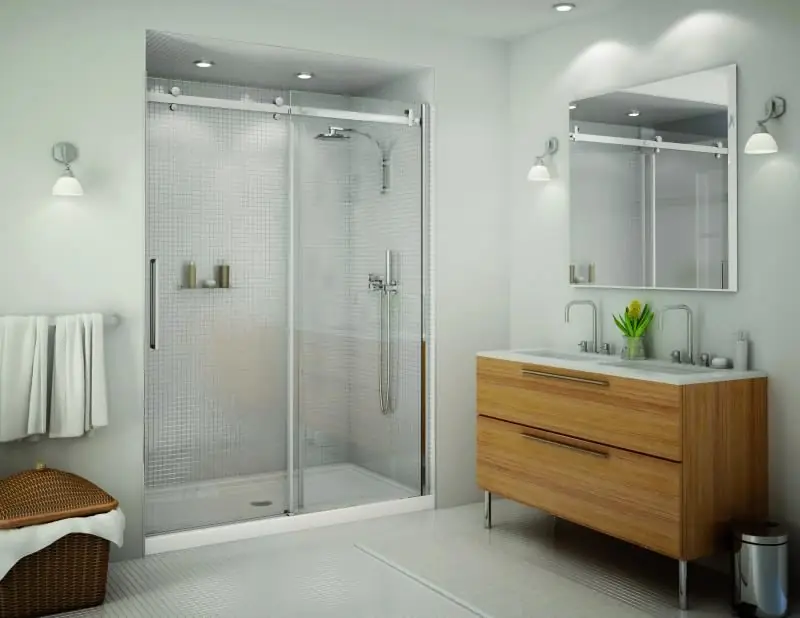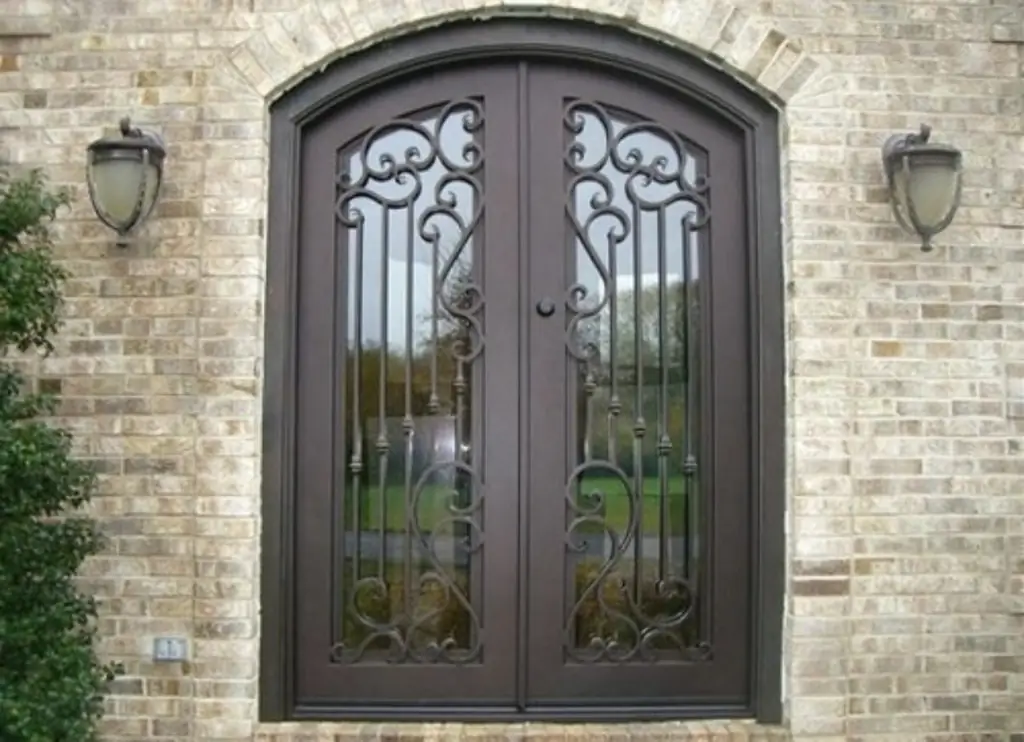
Table of contents:
- Author Bailey Albertson [email protected].
- Public 2024-01-17 22:26.
- Last modified 2025-06-01 07:32.
Frozen glass mosaic: do it yourself stained glass

Stained glass is experiencing its renaissance. Colored glass paintings are increasingly used by designers to decorate interiors in a variety of styles. Such a picture can decorate a room, become its accent, set the tone for the entire interior. But before the production of stained glass was a laborious and expensive business, while modern techniques allow you to create masterpieces on glass yourself.
Content
-
1 Styles and techniques
- 1.1 Where to place a stained glass window in an apartment
- 1.2 A few tips for choosing a pattern
-
1.3 Types of equipment
- 1.3.1 Video: making an English film stained glass with your own hands
- 1.3.2 Video: DIY Tiffany Stained Glass
-
2 What you need to make a stained glass window
-
2.1 Paints
- 2.1.1 Acrylic paints
- 2.1.2 Stained glass paints
- 2.1.3 Homemade paints
- 2.2 Outline
- 2.3 Required tools
-
2.4 Stencil for stained glass
- 2.4.1 Photo gallery: sample stencils for self-creation of a stained glass window
- 2.4.2 How to enlarge a picture
- 2.4.3 Application
-
-
3 Making a stained glass window: step by step instructions
- 3.1 Video: a master class for making a stained-glass window with a filling technique
- 3.2 Photo gallery: some ideas for placing stained glass in the interior
Styles and techniques
There are many styles of stained glass, because the stained glass itself appeared in the Middle Ages. Over time, it has changed, reflecting the cultures of different countries and eras, the emergence of new techniques made it possible to diversify the materials used. Nowadays, several styles are used to decorate rooms.
- Classical. Assumes symmetrical patterns, floral motifs, or geometric patterns. It is performed in warm, pastel colors. Appropriate in a classic interior with clear lines, solid, heavy furniture.
-
Gothic. This is the style of Catholic churches in medieval Europe. Twilight, upward aspiration of narrow lancet windows and high towers with spiers, dark red, scarlet, gold, green, blue, purple colors. It uses religious motives or scenes from the life of medieval knights, castles, feats, dragons, unicorns. The Gothic stained-glass window will add a touch of mystery and fabulousness to the space. It was during the Middle Ages that the most famous stained glass windows were created, recognized as masterpieces.

Gothic style stained glass Gothic stained glass - a fairy tale and mystery in your home
-
Modern. Perhaps a universal style for any interior. The main motives of this style are marine, the idea is the priority of form over content. This style is characterized by smooth whimsical lines, one way or another repeating the shape of the sea wave, grace, sophistication. Pale, muted colors, midtones, blue-green scale. Modern blends well with modern technology and gets along well with high-tech interior.

Art Nouveau stained glass Art Nouveau stained glass is appropriate in any interior
-
Abstract. Involves geometric patterns and bright, joyful colors. It does not conflict with almost any interior, except for the most orthodox. It brings a special emotionality to the space. In an abstract stained glass window, it is important to maintain a balance between form and color, and then he will never get bored, charging with optimism and encouraging creativity.

Stained glass in abstract style Abstract stained glass is suitable for any interior and will never get bored
- Egyptian. Faint paintings in sandy brown tones. The drawing reproduces Egyptian hieroglyphs, gods, pharaohs and scenes from their lives.
-
Antique. The paintings resemble antique mosaics with ancient Greek themes. The presence of many small details is characteristic. Suitable for minimalist rooms.

Antique stained glass Antique stained glass is often a finished piece
-
Byzantine. It is distinguished by the use of not only colored but also transparent glass, which makes the image appear to be hanging in the air. Such stained-glass windows resemble glass painting and are suitable for rooms filled with light.

Byzantine style stained glass The use of transparent glass in the Byzantine style creates the illusion of a picture floating in the air
-
Vanguard. The plot of the picture can be anything. But thanks to modern techniques of execution, it gives a sense of volume. The image is multi-layered, with three-dimensional details, on transparent or frosted glass, glossy, shining. Such a stained-glass window sets the tone for the entire room and makes it trendy.

Avant-garde stained glass Avant-garde stained glass can contain three-dimensional details
Stained glass in the interior creates a powerful accent, so it is important not to be mistaken when choosing a style. It should be in harmony with the general style of the room or set it. Then the rest of the interior items will complement and play with it, without creating dissonance.
Any glass or mirror surface can be decorated with stained glass. This will give the interior uniqueness, originality and a sense of luxury. It is appropriate to place the stained-glass window in any room.
Where to place a stained glass window in an apartment
-
Window. Stained glass will give the bedroom a feeling of coziness, and the nursery - fabulous. Stained glass in the window can be used as protection from the sun, hide the bathroom from prying eyes, add conviviality and comfort in the kitchen.

Stained glass on the balcony window A floral pattern on the balcony window will create the illusion of a country house
-
Doors. You can decorate both full glass doors and glass inserts. The drawing is best done in one style on all doors.

Stained glass on door inserts It is better to keep the drawing on all doors in the same style.
-
False windows. This glass painting is backlit and is often installed in bathrooms or stairwells.

False window A stained glass window will help to avoid the feeling of a closed space and additionally decorate the room
-
Ceiling lamps. Large glass shades or acrylic ceiling inserts will add originality to the interior.

Ceiling stained glass Gothic interior will decorate the stained glass ceiling
-
Glass partitions. They can be transparent or opaque. Such partitions are often installed between the kitchen and the bathroom, or the toilet and the bathroom. Stained glass lets in light, but does not allow you to see what is happening behind it.

Stained glass partitions Stained glass is a good solution for zoning a room
-
Furniture fronts, glass tabletops. Decorating furniture with stained glass is a good way to add personality to it. Even old furniture decorated with stained glass looks expensive and luxurious.

Furniture with stained-glass windows Stained glass inserts are appropriate for both living room furniture and kitchen
A few tips for choosing a pattern
- As already mentioned, the plot of the drawing should correspond to the general style and atmosphere of the room.
-
Dark tones and horizontal lines are suitable for spacious rooms with high ceilings, they visually reduce the space.

Stained glass in dark colors Dark tones of stained glass create an atmosphere of mystery, but visually reduce the space
-
Stained glass on the mirror is a good choice for small spaces. It will create a perspective of the space and visually enlarge the room.

Stained glass on the mirror Stained glass on the mirror will create a sense of perspective and expand a small room
- The abundance of bright colors and colorful images can tire over time. Consider this when choosing an ornament.
-
For the bedroom and nursery, it is better to choose calm, light colors that are conducive to relaxation.

Stained glass in the interior of the bedroom For the bedroom, it is better to prefer calm tones.
-
It is appropriate to decorate the kitchen with a landscape or still life, the bathroom - with a marine plot.

Stained glass with a marine theme Plots with fish are suitable for the bathroom
But not every stained-glass window can be done independently. There are several types of performance techniques.
Types of equipment
-
Classic or typesetting. The most difficult and ancient technique. Colored glass fragments are inserted into metal frames, assembled into a pattern and welded together. The technique requires special tools and skills. It is used for large structures and only by professionals.

Stained glass in classical technique Classic stained glass is indispensable for large areas
- English or film. The drawing is formed on glass from a self-adhesive stained glass film. Each piece is cut out separately and glued to the place determined by the stencil. The glued fragments are framed with lead tape. With certain skills, such a stained glass window can be made independently.
-
Fusing. Stained glass is made without a metal frame by sintering multi-colored fragments into a monolithic pattern. It is impossible to make such a stained-glass window at home; a special oven with a high temperature is required.

Fusing Fusing stained glass strikes with the brightness of colors and the integrity of the composition
-
Tiffany. This technique is similar to the classical one. Fragments of the pattern are cut out of colored glass and edged with copper tape. The finished elements are assembled into a pattern and welded together. For beginners, this technique is difficult, but it is quite possible to master and use it at home.

Tiffany stained glass Tiffany stained glass successfully replaces the classic technique
- Sandblasting. It consists in stencil processing of glass with sand supplied under high pressure. The treated areas become dull, and the pattern becomes airy. Not used at home, requires special equipment.
- Cast. Each element is molded or blown from glass separately. After that, the fragments are assembled into a picture using reinforcement or mortars. Not applicable at home.
- Etching. By etching glass with hydrofluoric acid, deep relief patterns are created. Home use of this strong acid is hazardous to health.
-
Painted stained glass window. The pattern is copied onto the glass and outlined. After the contour has dried, the voids are painted with stained glass paints.

Painted stained glass You can create real paintings using the painted technique
-
Contour filler. As with the painted technique, the outline of the drawing is first prepared. After it dries, the voids are filled with thick paints. If necessary, the paint is leveled with a brush or a wooden stick.

Stained glass in flood technique The pouring technique best mimics the classic styles
Video: making an English film stained glass with your own hands
Painted stained-glass windows and contour filling techniques are most available for self-production. They do not require special knowledge, materials and tools, and can imitate almost any other technique. To make such stained-glass windows, you only need special paints, accuracy and patience.
Video: do-it-yourself stained glass in Tiffany technique
What is needed to make a stained glass window
Prepare everything you need before starting work. Paints are needed for painted and flooded stained glass.
Paints
Special stained glass or acrylic paints for glass are used. They all have their own characteristics.
Acrylic paints
It contains three main components: pigment, water and acrylic polymer emulsion. Sold in tubes or cans.

Acrylic paints are sold in cans and tubes
Acrylic paints dry quickly, after which they become resistant and elastic. After drying, they are resistant to temperature and humidity changes. It is very difficult to scrape off the dried coating, as well as to remove it with sandpaper.

Acrylic paints dry quickly and are easy to use at home
The color of the finished coating is matte and bright. It does not fade and does not tarnish over time. Paints of different colors can be mixed with each other. The brush is washed off immediately after use with water, for a dried one you will have to use a solvent.
Stained glass paints
There are two types: fired and non-fired. Fired after application are heated in the oven, harden and become resistant to external influences. The firing temperature is indicated by the manufacturer on the packaging.

Stained glass paints can be fired and non-fired
If the paints are not burned, after a week they will dry out and harden in the same way as during firing, but until then there is a risk of greasing them. Water-based paints, therefore, are diluted with it. Brushes can also be washed with water.
Non-firing paints dry from 1 to 3 days, depending on the manufacturer. The drawing requires fixing by applying a layer of nitro-varnish.
These colors are brighter. They are thicker due to the synthetic solvent included in their composition. They fit well, it is more convenient to work with them on vertical surfaces.
Homemade paints
Some masters also prefer to use paints of their own production. They are easy to make yourself from what is sold in hardware stores.
- Based on nitro lacquer. NTs-2141 or other similar is used. Nitrolac is diluted with solvent 647, in a ratio of 1 to 0.4. It is tinted with artistic oil paint or construction color. The dye is added little by little until the desired color intensity is achieved.
- Based on BF-2 glue. The glue is diluted in half with acetone, tinted with any alcohol-based dye. This can be ballpoint pen paste or other paint. The emulsion is stirred in a glass container and tasted on the glass. Add paint if necessary until the required intensity is reached.
- On a gelatin basis. 5-6 g of gelatin are brewed with 200 ml of hot water until the consistency of a paste and the dye for the fabric is added. Drawing from such paint requires fixing with nitro varnish.
In addition to paints, you will need a contour for work. This is a special thick paste for drawing the borders of the pattern. It imitates metal frames for pieces of smalt in painted and flooded stained glass windows.
Circuit
Relief contours are water-based and sold in tubes. With their help, the drawing is outlined with a contour, which is then filled with paints. It can also be used to create a three-dimensional drawing.

Stained glass contours can be used to create a three-dimensional pattern
At home, contour paste can be prepared on the basis of PVA glue. To do this, you will need 50 ml of dishware PVA, 20-30 ml of natural black ink (the best is Dutch), 30-40 grams of silver or bronze powder.
With constant stirring, ink is introduced into the glue, and then powder, until a creamy consistency is obtained. This paste is prepared as needed, it is not stored. Stir each time before use. Masters apply it with a brush, forming a roller, it is more convenient for beginners to use a pastry syringe.
Required tools
For the production of stained glass using different techniques, a special tool is required. In the hand-drawn and filling technique, you will need a minimum:
- ruler;
- pencil;
- glass marker;
- brushes;
- wooden sticks or toothpicks.
And of course, making a stained glass window is impossible without a stencil drawing. Let's take a closer look at how to do it.
Stencil for stained glass
A suitable stencil can be obtained from a specialty store or from a stained glass artist. But it is much more interesting to make a stencil yourself, choosing a suitable sketch.
The image can be downloaded from the Internet and simply printed at the desired scale, taking into account the dimensions of the future stained glass window. Or take your favorite picture, postcard and enlarge to the required size.
Photo gallery: sample stencils for creating a stained glass window yourself
-

Flower sketch - Floral motifs never go out of style and are suitable for any space
-

Floral stencil - Stencil details are numbered for ease of painting stained glass
-

Flower sketch with lattice - The lattice complements the flower and gives the design a finished look
-

Sketch with birds - Birds are another timeless story for stained glass
How to enlarge a drawing
- Draw the drawing into cells with a side no more than 1 cm.
- Number the resulting grid vertically and horizontally.
- Take measurements from the stained glass.
- Transfer the dimensions to paper.
- Mark the sheet according to the number of cells in the picture.
- Draw a grid on the sheet according to the layout.
- Transfer the image from the postcard onto the paper at an enlarged scale, cell-by-cell.
- The finished drawing can be corrected, changed colors.
If you are proficient in drawing, you can create a pattern yourself. To do this, transfer the dimensions of the future stained-glass window to a sheet of paper and mark the contours of the pattern location. Draw with a simple pencil so that you can correct inaccuracies.
Draw in the details, you should get a complete picture. Draw the finished drawing around the contour with a ballpoint pen or a thin marker.
Application
- Transfer the dimensions of the glass to paper.
- Cut out pieces of art from a magazine or poster. The main thing is that they fit in size.
- Draw out the lines of the background, simulating pieces of smalt.
- Sketch out the lines of the future drawing, marking the places for the cut out parts.
-
Stick the fragments.

Stencil creation The stencil can be created using the applique method
- Correct the image by adding details.
Having prepared everything you need, you can start making the stained glass window. Make sure the work surface is level and remember that the glass can break if handled roughly.
Making a stained glass window: step by step instructions
- Lay the glass on the prepared stencil so that their edges coincide.
- Degrease the glass thoroughly with alcohol, acetone or vinegar. Dry the surface with a dry, lint-free cloth.
-
Transfer the contours of the drawing from the stencil to the glass with a special disappearing marker. If you have experience in drawing, lines can be applied immediately with a contour or contour paste.

Contour drawing Contouring requires precision and precision.
- Let the outline dry, otherwise the drawing will smear.
-
Now it remains only to fill the voids of the drawing with paints. This is done with a thin brush or directly from the tube. Tubes of ready-made paints are equipped with a convenient spout.

Paint application Paints are applied to the stained-glass window with a brush or with a tube attachment
- The paint is applied from the edges to the center. It's not scary if during the work the paint gets on the contour - touch it up with a wooden stick or a toothpick. After drying, the special paints become transparent and the contour will show through them.
- If the drawing provides for color transitions, lighter or darker tones are applied after the base. They can be mixed or shaded with basic ones with a toothpick.
- The bubbles formed during operation are also removed with a toothpick.
- Let the finished painting dry completely. Some paints need to be additionally coated with nitro varnish, pay attention to this. This information is indicated on the packaging.
-
It remains only to insert the stained glass into the frame.

Finished stained glass Stained glass can be inserted into the frame
Video: a master class for making a stained-glass window with a filling technique
Having mastered painting and filling techniques, you can try yourself in English film or fusion techniques. It will take a lot of money, materials and skills, but it's worth it.
Photo gallery: some ideas for placing stained glass in the interior
-

Stained glass in the living room - Abstract drawing is suitable for high-tech style
-

Window with stained glass - Floral ornament will decorate the living room windows
-

Stained glass in the bathroom window - Stained glass on the bathroom window will give a special atmosphere and protect from prying eyes
-

Geometric pattern stained glass - A geometric pattern for the living room is easy to make with stained glass film
-

Stained-glass staircase windows - Stained-glass windows of the staircase are made in the same style
-

Stained-glass windows in the bay window - Bay windows are good for stained glass
-

Stained glass on the ceiling - Ceiling insert can be decorated with foil stained glass
Stained glass making is a creative and exciting activity. Even children can make the simplest stained-glass windows. And let your work not be like the masterpieces of world painting, but they will bring originality and a particle of your individuality to your home.
Recommended:
How To Wipe Off The Glue From The Adhesive Tape - Remove Traces Of Ordinary, Double-sided, Painting From Plastic, Furniture, Glass, Clothes And Other Surfaces + Photos And Videos

Everyone uses scotch tape, and sometimes unpleasant traces remain after it. How to wipe off adhesive from plain or double-sided plastic, furniture, glass or clothing
Raspberry Eurasia - Description Of The Variety, Photos And Characteristics, Advantages And Disadvantages, Planting And Care Features With Photos And Reviews

Description of remontant raspberry Eurasia, features of planting, care, advantages and disadvantages of the variety. Photo and video
Glass Doors And Partitions For Bathroom And Shower: Types, Device, Components, Installation And Operation Features

Doors and partitions for bathroom and shower made of glass: varieties, selection of accessories. Manufacturing and installation. How to care for glass doors. Reviews
Glass Entrance Doors: Varieties, Device, Components (including Glass), Installation And Operation Features

The device and types of entrance doors with glass. Repair and adjustment, troubleshooting. Fittings for doors with glass. Maintenance and care
Interior Doors Are Glass Or With Glass Inserts: Varieties, Device, Components, Installation And Operation Features

Arrangement of different types of doors made of glass and with glass inserts. Choice of accessories and door mounting technology. Breakdown and repair of interior doors
